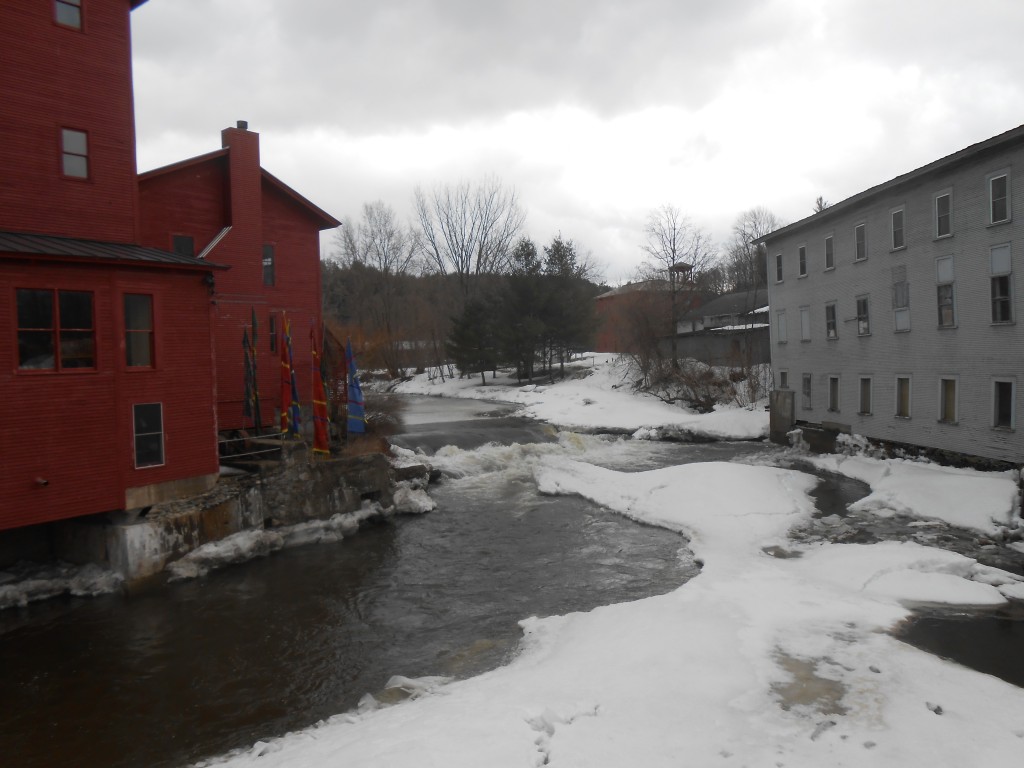Observed on April 8, 2014: A few days ago, although a low rapid gushed on the far side of the bridge, the Gihon river was mostly covered with ice. You knew water must be flowing under it, but except for a thin stream along the shorelines, the surface was white, cold, and still. Yesterday, the ice began breaking up a bit and, today, the river is suddenly flowing fast in a snake-like curve around the remaining broken ice beneath the bridge, a swirl of tiny ice-shards roiling down the middle, as the water comes. The sudden power, after the days of seeming stillness, invigorates, instilling a sense of anticipation, excitement, even danger—power now exposed, not hidden.
A green-headed wild duck darts from the sky straight at the water, but somehow ends its dive on its belly, treading water in the middle of the river, paddling against the current, moving a little upstream, and then paddling towards the shore. A piece of ice about the duck’s own size crosses its path, but just misses hitting it. My studio window gives me a good view of the flowing river.
In my short time at VSC, the resident writers (no more than sixteen of us) and artists (the balance of approximately 50 people) had a wonderful spirit of playfulness and curiosity as well as an appreciation for and encouragement of each other’s work. This was true not only within disciplines, but between them. When the writers got together for their informal readings, artists were welcome to come and listen, but also to participate if they had something written they wanted to try out. Some were fascinated to see the writer’s process–how we develop our work and analyze what we have done. Writers (at least this writer) were welcomed into studios where the visual artists were happy to take time out to talk about what they were working on and their process. I was fascinated by the visual artists’ experimentation with the tools of their various media. Just as I might play with writing devices, many of them experiment to see how one medium will affect another (eg. the effect created by spilling cleaning fluid on a color magazine photo).
Meals are communal there, and conversation at lunch or dinner, when not happily silly, often was a time when you might be asked what you were working on or how the work was going and thus given an entrée to talk out a problem you had with your work, or bounce an idea off of someone, or become inspired by an idea or problem they were working out.
In addition, during each two-week period (most artists stay for one month), there is at least one writer or poet who comes for some days as a visiting writer, gives a reading, a craft talk, and meets with those who want critique of their work. (In my two-week period, the writer was Rikki Ducornet.) Likewise, there are painters and sculptors who come to give a talk and slide show of their work and visit with visual artists who want a critique. (in my time, these were Kyle Staver and Kim Jones). The resident writers (who wish to) have an opportunity to give formal readings once per week, and the resident artists (who wish to) likewise have the opportunity to give slide shows of their work. Other than these events, we made our own fun: bonfires, roasting marshmallows, Karaoke at the local Italian bar/restaurant on a Saturday night, a Friday night dance party in the Red Mill dining hall’s downstairs lounge (organized informally), even a makeshift séance. One poet was working on a series inspired by Hitchcock’s oeuvre, and so, with her, one night, a small group of us watched a dvd of Rear Window together. And through it all, the beer, and wine, and chocolate flowed. (And coffee and tea and marshmallows and chips, too.)
The creative impulse and comradeship we found together in this month of April was far more free-spirited than I have experienced at any previous residency. I think I can speak for many of us when I say that our greatest desire is to find ways to sustain that spirit and those supportive friendships now that we have come home and back to our everyday lives.

